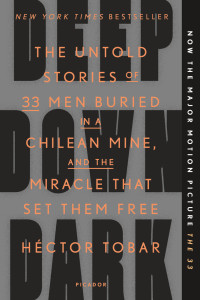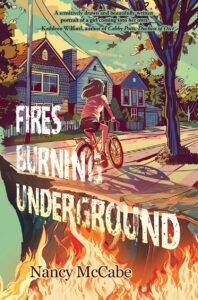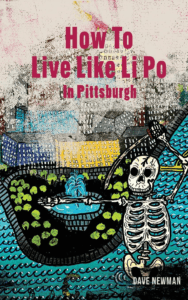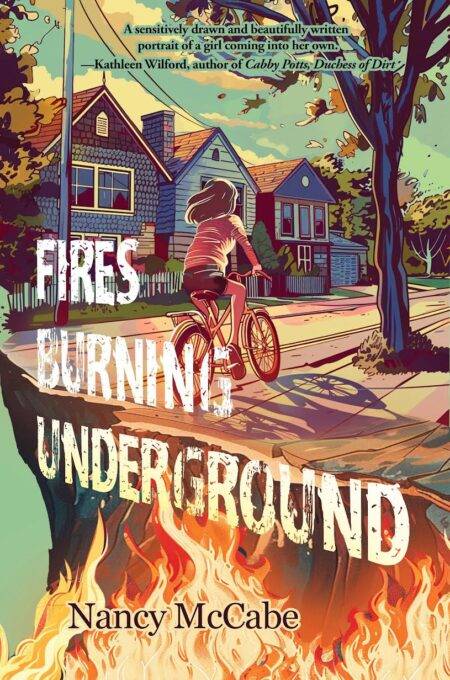Héctor Tobar will be speaking at Pittsburgh Arts and Lectures on September 21st. In anticipation of this event, Littsburgh is honored to share with you the first chapter of Pulitzer Prize-winning author Héctor Tobar’s most recent book, Deep Down Dark.
Deep Down Dark — “The Untold Stories Of 33 Men Buried In A Chilean Mine, And The Miracle That Set Them Free” — was a finalist for a National Book Critics Circle Award, a finalist for a Los Angeles Times Book Prize, and a New York Times Book Review Notable Book. It has been adapted into a major motion picture, The 33, which will be in theaters nationwide this November.
The first chapter of Deep Down Dark is reprinted here courtesy of Picador USA.
A Company Man
 In the San José Mine, sea level is the chief point of reference. The five-by-five-meter tunnel of the Ramp begins at Level 720, which is 720 meters above sea level. The Ramp descends into the mountain as a series of switchbacks, and then farther down becomes a spiral. Dump trucks, front loaders, pickup trucks, and assorted other machines and the men who operate them drive down past Level 200, into the part of the mountain where there are still minerals to be brought to the surface, working in passageways that lead from the Ramp to the veins of ore-bearing rock. On the morning of August 5, the men of the A shift are working as far down as Level 40, some 2,230 vertical feet below the surface, loading freshly blasted ore into a dump truck. Another group of men are at Level 60, working to fortify a passageway near a spot where a man lost a limb in an accident one month earlier. A few have gathered for a moment of rest, or idleness, in or near El Refugio, the Refuge, an enclosed space about the size of a school classroom, carved out of the rock at Level 90. As its name suggests, the Refuge is supposed to be a shelter in the event of an emergency, but it also serves as a kind of break room because fresh air is pumped into it from the surface, offering a respite from the humidity and heat, which often reaches 98 percent and 40° Celsius (104° Fahrenheit) in this part of the mine. The San José is said by the men who work there to be like hell, and this is a description with some basis in scientific fact, since it’s the geothermal heat emanating from the bowels of the Earth that makes the mine hotter the deeper they go.
In the San José Mine, sea level is the chief point of reference. The five-by-five-meter tunnel of the Ramp begins at Level 720, which is 720 meters above sea level. The Ramp descends into the mountain as a series of switchbacks, and then farther down becomes a spiral. Dump trucks, front loaders, pickup trucks, and assorted other machines and the men who operate them drive down past Level 200, into the part of the mountain where there are still minerals to be brought to the surface, working in passageways that lead from the Ramp to the veins of ore-bearing rock. On the morning of August 5, the men of the A shift are working as far down as Level 40, some 2,230 vertical feet below the surface, loading freshly blasted ore into a dump truck. Another group of men are at Level 60, working to fortify a passageway near a spot where a man lost a limb in an accident one month earlier. A few have gathered for a moment of rest, or idleness, in or near El Refugio, the Refuge, an enclosed space about the size of a school classroom, carved out of the rock at Level 90. As its name suggests, the Refuge is supposed to be a shelter in the event of an emergency, but it also serves as a kind of break room because fresh air is pumped into it from the surface, offering a respite from the humidity and heat, which often reaches 98 percent and 40° Celsius (104° Fahrenheit) in this part of the mine. The San José is said by the men who work there to be like hell, and this is a description with some basis in scientific fact, since it’s the geothermal heat emanating from the bowels of the Earth that makes the mine hotter the deeper they go.
The mechanics led by Juan Carlos Aguilar find respite from the heat by setting up a workshop at Level 150, in a passageway not far from the vast interior chasm called El Rajo, which translates loosely as “the Pit.” Air circulates through the Pit and the faintest hint of a breeze flows from that dark abyss into the makeshift workshop. The mechanics have decided to start their workweek by asking Mario Sepúlveda to give them a demonstration of how he operates his front loader. They watch as he uses the clutch to bring the vehicle to a stop, shifting from forward directly to reverse without going into neutral first.
“Who taught you to do that?” the mechanics ask. “That’s wrong. You’re not supposed to do it that way.” He’s mucking up the transmission by doing this, wearing out the differential.
“No one ever showed me,” Sepúlveda answers. “I just learned from watching.” The mechanics work for a company that contracts maintenance services to the mine, and they are not surprised to learn that an employee of the San José is operating an expensive piece of equipment without having received any formal training. The San José is an older, smaller mine known for cutting corners, and for its primitive working conditions and perfunctory safety practices. Among other things, it has vertical escape tunnels that will be useless in an emergency because they lack the ladders necessary for the miners to use them.
Newly informed as to the proper use of the clutch, Sepúlveda leaves the mechanics to work down at Level 90.
Throughout the morning, the mountain has continued its intermittent thundering wail, the sound of a distant explosion followed by a long whining sound. Carlos Pinilla, the general manager of the San Esteban Mining Company, hears this noise as he travels in a pickup truck between the levels of the San José Mine. He has an office on the surface, but is now deep inside the mountain to impose some discipline on a workplace that’s much too casual for his liking. “I had to reprimand everyone from the shift supervisor on down,” he says. “None of these guys was a little white dove. I didn’t want them to be afraid of me. But if I’d go down there and find six guys sitting around chatting, I wanted them to at least stand up when they saw the boss. Without that, everything would start to fall apart…”
Pinilla is a jowly man of about fifty who’s worked his way up from lowly office jobs in mining companies to one in which he’s the general manager of the two mines run by the San Esteban Mining Company. He’s described by his underlings as imperious, the kind of a man who will bark an order and who treats the miners as if their sweating, helmeted presence were offensive to him somehow. In a country of rigid class distinctions, such as Chile, laborers are often subjected to bald condescension by the salaried classes. Even in this context, to the miners Pinilla stands out as an especially domineering “white helmet,” particularly in contrast to the soft-spoken white helmet beneath him in the mining hierarchy, the shift supervisor Urzúa. In recent weeks, one of the members of the A shift, Daniel Herrera, had asked Pinilla several times for replacement air filters for the masks the men wear, until, he claims, the general manager finally replied, sarcastically: “Yeah, I’m going to get you a whole truck filled with filters!” Pinilla is “el amo de la mina,” the miner Jorge Galleguillos says, lord and master of the mine. Galleguillos is fifty-six, and older men like him are afraid of Pinilla because he can fire a man in an instant, leaving him in the unenviable position of looking for work in an industry where youth and a stout constitution are especially prized. At the same time, it’s only the older, most experienced miners who have dared to speak out in the face of the mounting evidence of the San José Mine’s structural weakness.
After 121 years in which men and machines have emptied and hollowed the mountain, the San José Mine is still intact thanks to the hard, gray diorite stone that makes up most of the mountain’s mass. In mining slang, the diorite is “good” rock in the sense that it holds together when you drill through it. If the ore-bearing rock is like a crumb cake that begins to disintegrate as soon as you poke it, the diorite is more like a stiff custard. Generally speaking, the diorite provides an excellent, stable structure for a tunnel, requiring relatively little reinforcement. The Ramp has been carved through this stone, and is the only true way in and out of the mine. Until recently, no one who works in the San José believed it was in danger of collapsing. Then, several months back, a finger-wide crack was discovered in the Ramp at Level 540.
Mario Gómez showed the crack to his shift supervisor as soon as he saw it. Gómez is a sixty-three-year-old miner who drives a thirty-ton-capacity truck into the mine. “I’m pulling my truck out of this mine,” Gómez said then. “And I’m not going back in, and no one else will, until you get the mine manager and the engineers here from Copiapó, and make them look at this and evaluate it.” A few hours later, the engineer and the general manager arrived. They placed mirrors inside the half-inch-wide crack: If the mountain was still shifting and splitting, then the movement would break the mirrors. But the mirrors are still intact.
“Look, the Ramp is the safest thing in this mine,” the manager said to the miners. “All that cracking is coming from the Pit. The walls of the Pit can collapse up to five meters away and nothing will happen to the Ramp.” More mirrors were placed in the crack when water began to leak through it, but they all remained in place and intact for weeks and months. Galleguillos studied the mirrors every time he drove past one. He wrote down other troubled observations in a notebook: “Falling material is felt at Level 540 … tunnel walls detached at Level 540.” Then he forced the mine manager to sign a copy of these notes. Later, he confronted the manager again.
“How do we know you’re not going in and replacing those mirrors when we’re not looking?” Galleguillos asked.
“What are you?” the manager snapped back. “A coward?”
Now Pinilla crosses paths several times with the workers as he patrols the interior of the mine in his pickup truck. At midmorning, Yonni Barrios and his crew of fortifiers see him at Level 60, and tell him the mountain is making noises you ordinarily can’t hear that far down. “Don’t worry,” he tells them, “the mountain is just settling” (“el cerro se está acomodando“). Higher up, at Level 105, another group of workers has a similar conversation. The thunder can be heard in every corner of the mine, and it’s causing a sense of worry to spread through the passageways—and also a sense of denial. Mining is an inherently dangerous occupation, and those who have decades of experience working underground take pride in facing its risks. The men of the A shift have made it a habit of complaining to their wives and girlfriends about the San José, using the preferred euphemism that conditions in the mine are “complicated,” and then brushing off the danger when pressed for details.
Luis Urzúa, too, has told his wife the San José is “complicated,” and when he took the job there a few months ago, it was in full knowledge of the mine’s recent accidents. This morning he’s hearing the complaints about the thunder from his crew, including a few who insist they should all go to the surface. Urzúa says to wait. Urzúa is fifty-four years old, and despite his degree as a mining topographer, he freely admits that he’s intimidated by people who are “bigger” than he is. He could confront his boss, Pinilla, and demand that all his men be pulled out: In fact, a few of the men of the A shift are starting to think he’s weak for failing to do so. But at this moment none of those men complain very loudly either, nor do they announce that they will simply refuse to work a minute longer and leave the mine immediately, a step men at the San José have taken before.
Mario Gómez, the oldest man in the A shift, has two missing fingers on his left hand as a reminder of what can happen underground from one moment to the next. At about 12:00 p.m., he, too, is given a warning of the impending disaster: There’s “smoke” coming from Level 190, the driver Raúl Villegas tells Gómez as the two men and their dump trucks pass each other on the Ramp. But Gómez listens to the tough, gruff voice in his head that tells him he should be careful but not fearful. When he drives past the “smoke” and takes a look he concludes: It’s just dust, and dust is normal in the mine.
Still, the reports of unusual noises and explosions keep coming, and by late morning the boss of all the bosses, Carlos Pinilla, is, according to several of his underlings, starting to act strangely. Urzúa and his second-in-command, the foreman Florencio Avalos, spot him in his pickup at Level 400. Pinilla stops to shine a large flashlight at the stone walls of the Ramp, and another worker who spots him at this moment says: “His flashlight was huge, so much bigger than the ones we carried, that it made me nervous to see him using such a thing.” Later, other workers see him going into one of the corridors that lead off the Ramp to shine the same flashlight inside the cavernous, excavated space of the Pit. They also see him standing next to the pickup truck, as if he were listening for something, or trying to feel movement inside the mountain. He seems to be listening, too, when he stops at the entrance to corridors near Level 400, to wipe clean the blue-and-white placards reading “DO NOT ENTER” and “BYPASS.” “I thought that was strange,” Urzúa says, “to see my jefe cleaning the traffic signs.” When Florencio Avalos comes upon Pinilla a little bit after noon, the general manager tells him he has a flat tire and needs to get a spare as quickly as possible. “He seemed nervous,” Avalos says. “As soon as we changed the last bolt, he took off, and we never saw him again.”
As Pinilla drives toward the surface at around 1:00 p.m., he crosses paths on the Ramp with Franklin Lobos, a tall, balding onetime soccer star and minor local celebrity whose chief fame underground is that he’s a grouch. Lobos drives the personnel truck that ferries the men in and out of the mine, and at that moment he’s headed down to pick up the men for lunch.
“Franklin, I’d like to make two observations to you,” Pinilla says. “First, I want to congratulate you, because you have the Refuge nice and clean.” The Refuge is stocked with two metal cabinets with food, supposedly enough to keep an entire shift alive for two days. As the driver of the personnel truck, Lobos holds the keys to those cabinets and is responsible for keeping the Refuge in order. “And second,” Pinilla continues, “as soon as you can, I want you to go and talk to the supply master. Because we’re getting a box ready with more provisions for the Refuge.” More food, blankets, and a first-aid kit, that sort of thing, Pinilla says.
Pinilla seems to be in a hurry to leave the mine, and is making preparations for an emergency, but he says it isn’t because he thinks the mine is about to collapse. His biggest concern isn’t an accident in the mine, but rather that the Chilean government agency in charge of mining safety will close down the mine. The big flashlight was required for a routine inspection of the excavated cavern of the Pit: Given that it’s as much as six hundred feet tall in places, he needs an especially powerful beam. And he’s just ordered that more emergency supplies be taken to the Refuge because the miners are always stealing the food inside (he’d finally bought a lock and an aluminum band to keep them from doing so), and if an inspector finds the supplies lacking he’ll shut down the mine.
In 2007, the Chilean government had ordered the San José Mine closed after an underground explosion of rock killed the geologist Manuel Villagrán. The mine owners promised the government they would take a series of steps to improve safety, and the San José was allowed to be reopened. (The men built a shrine of votive candles to Villagrán at the spot where he died and where the vehicle he was driving remains buried.) Unlike other mines in the Copiapó region, the San José is not owned by a big foreign conglomerate, but rather by two sons of the late Jorge Kemeny, an exile from Communist Hungary who settled in this part of Chile in 1957. Marcelo and Emérico Kemeny did not, unfortunately, inherit their father’s passion and skill for the mining business. Emérico left his share of the work of owning the mine to his brother-in-law, Alejandro Bohn. The Kemenys and Bohn struggled to keep the San Esteban Mining Company profitable while complying with the Chilean government’s demands. The company was required to install ladders inside the ventilation tunnels as an alternate emergency escape to the Ramp, and also new fans to increase air circulation and lower the temperature at the bottom of the mine, which at times neared 50° Celsius (122° Fahrenheit). As if in recognition of their previous shortcomings on safety, the owners then contracted with a company called E-Mining to take charge of the mine’s daily operations. E-Mining recommended a seismic monitoring system designed to detect potentially catastrophic shifting of the mountain’s internal structure; it was never purchased. The contractor also recommended other movement-detection devices known as geophones, but after a month they stopped working because the mine’s trucks kept running over their fiber-optic cables. Eventually the San Esteban fell behind in its payments to E-Mining, and the company canceled its contract and withdrew its employees. The San Esteban then hired a former San José employee, Carlos Pinilla, to take the contractor’s place. The San Esteban company doesn’t have enough money to pay for the seismographs, or to keep the geophones operational, nor has it installed the ladders or the ventilation systems the government ordered. Basically, it’s impossible to do those things and still keep their medium-size mine profitable. Among other things, the company is $2 million in debt to ENAMI, a government-owned company that processes ore for small- and medium-size mines. Just like the workers who know how dangerous the San José is and work there anyway, the owners know how dangerous it is and keep it open nonetheless. To keep the company and its financial ambitions and responsibilities afloat, they’re gambling with the miners’ lives.
As he drives to the surface, Carlos Pinilla is doing exactly what the owners have always asked him to do: keep the mine running, with the cash-producing ore coming out, while cutting corners to keep costs down, hoping for the best, trusting that the very hard diorite of the Ramp will hold together and allow the men to escape, even if the internal structure of the mountain, weakened after more than one hundred years of digging and blasting, causes the rest of the mine to crumble.
If Pinilla closes the mine and orders everyone out, and the mine doesn’t collapse, it might cost him his job. And besides, he believes at this moment that the San José Mine has at least another twenty years left in it.
Just after 1:00 p.m., two men cross paths on a road carved out of stone: One is headed up, the other down. Carlos Pinilla, the man in the white helmet who worked his way up from warehouse clerk to general manager, revs the engine of his pickup to begin to climb to the surface and daylight. Franklin Lobos, a man whose fortunes have been in a precipitous decline, watches from beneath a blue helmet as the jefe drives away. Lobos reaches over and releases the emergency brake on his truck, so that gravity does the first bit of the work of sending him on his journey downward. He turns on the fog lamps—the main beams of the truck’s headlights have never worked—and heads down to the Refuge, below Level 100, where the men are starting to gather and wait for him for the ride up for lunch.
Descending a bit more, at Level 500, Lobos sees a truck coming up, and since uphill traffic has the right of way, he lets it pass: It’s Raúl Villegas, the driver who’s just complained about “smoke,” driving a big dump truck filled with tons of ore.
The men wave hello and goodbye to each other and soon Lobos is on his way down again. He reaches Level 400, where the signs gleam a little brighter thanks to Pinilla’s polish job. The older miner Jorge Galleguillos is riding in the cab alongside Lobos, going down to check on the system of tanks and hoses that brings water from the surface down into the mine. The drive is slow and tedious, following the ground-hugging beam of the truck’s fog lamps along a single gray tunnel, sinuous and repetitive, as if they were entering the dark, dank, and vacant landscape of a miner’s subconscious. A half hour longer they drive, one rocky turn following another, in passageways with a million ragged, serrated edges blasted from rock. They are at about Level 190 when they see a white streak move past the truck’s windshield from right to left.
“Did you see that?” Galleguillos says. “That was a butterfly.”
“What? A butterfly? No, it wasn’t,” Lobos answers. “It was a white rock.” The mine’s ore-rich veins are thick with a translucent, milky quartz that glimmers when it catches the light.
“It was a butterfly,” Galleguillos insists.
Lobos believes that it’s pretty much impossible to think that a butterfly could flutter down in the dark to more than a thousand feet below the surface. But for the moment he surrenders the argument.
“You know what, you win. It was a butterfly.”
Lobos and Galleguillos continue driving for about twenty more meters. And then they hear a massive explosion, and the passageway around them begins to fill with dust. The Ramp is collapsing directly behind them, near the spot where a rock or a butterfly passed before their windshield.
* * *
The sound and the blast wave interrupt thirty-four men laboring inside stone corridors. Men using hydraulic machines to lift stone, men listening to stone crash against the metal beds of dump trucks, men waiting for the lunch truck in a room carved from stone, men drilling into stone, men driving diesel-fed machines down a stone highway, and men wearing eroded stone on their clothes and their faces.
The truck driver Raúl Villegas is the only one of the thirty-four men underground at the moment of the collapse who manages to escape. He watches in horror as a dust cloud gathers in his rearview mirror and quickly overtakes his truck. He speeds through the cloud toward the exit, and when he reaches the mouth at which the Ramp opens to the surface, the dust follows him outside. A gritty brown cloud will continue flowing out of that malformed orifice for hours to come.
Inside the personnel truck at Level 190, Lobos and Galleguillos are the two men closest to the collapse, which hits them as a roar of sound, as if a massive skyscraper were crashing down behind them, Lobos says. The metaphor is more than apt. The vast and haphazard architecture of the mine, improvised over the course of a century of entrepreneurial ambition, is finally giving way. A single block of diorite, as tall as a forty-five-story building, has broken off from the rest of the mountain and is falling through the layers of the mine, knocking out entire sections of the Ramp and causing a chain reaction as the mountain above it collapses, too. Granitelike stone and ore are knocked loose, pulled downward to crash against other rocks, causing the surviving sections of the mine to shake as if in an earthquake. The dust created and propelled by the explosions shoots sideways, upward, and downward, ejected from one passageway and gallery in the mine’s maze of corridors to the next.
In an office about one hundred feet above the mine opening, Carlos Pinilla, the hard-driving general manager, hears the thunder crack and his first thought is: But they’re not supposed to be blasting today. He concludes that it’s probably another collapse of rock inside the Pit, which is nothing to be worried about. But the sound of rolling thunder doesn’t stop. His phone rings, and the voice on the line says, “Step out your door and look at the mine entrance.” Pinilla walks into the midday sun and sees a billowing cloud of dust bigger than any he’s seen before.
Copyright © 2014 by Héctor Tobar
Shared here with permission of Picador USA.

























